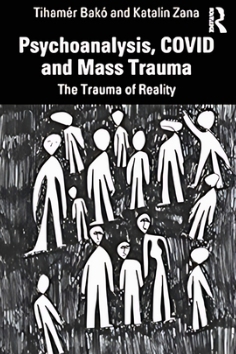Issue Archive
Book Review: Psychoanalysis, COVID & mass trauma: The Trauma of reality

By Tihamér Bakó & Katalin Zana
Translated by R. Robinson. Routledge
2023
It is widely agreed in the academic community that COVID-19 is a contemporary event of loss and trauma (see Miller, 2020). The reality of global and pervasive trauma forced mankind to stand together for the first time in history in the face of uncertainty, loss, vulnerability, and death.
Trauma is cognitively harmful (Stolorow, 2011, 55), separating (Ferro & Foresti, 2008, 1046), hurtful to people’s structure of external reality and trust-building (Oliner, 1996, 286-287), and blurring the limits of the self. Based on the above understanding of trauma and their own original thoughts on group-level trauma, two Hungarian psychoanalysts, Tihamér Bakó and Katalin Zana, are eager to tell readers in the book Psychoanalysis, COVID, and Mass Trauma: The Trauma of Reality (2023) the impact of the intense event on an individual, the threshold at which it becomes traumatic, the differences in the experience when it occurs in a group. This necessitates the portrayal of painful reality both inside and outside of the individual, as well as sufficient attention to the here-and-now during COVID-19 between February 2020 and the end of July 2021.
The book, with comprehensive clinical diaries by both writers and abundant oral history of patients from many walks of life, gives a wonderful example today to make the academic context recount the role of diaries, the medium from which psychoanalysis was founded and evolved (i.e., Sigmund Freud’s Interpretation of Dreams and Sándor Ferenczi’s Clinical Dairies, among others). The journal itself is an important historical record of social suffering and the horrific mental reality that we all faced at the time. It also provides us with anew resource to re-examine clinical practice for trauma and even the subject of psychoanalysis in the aftermath of the massive health catastrophe that shares power but differs in nature from the two world wars witnessed by many senior analysts such as Freud, Otto Rank, D. W. Winnicott, Wilfred Bion, and others.
Theory: The Transference of You with Me
“My mom was unexpectedly diagnosed as a COVID patient,” one of my dearest friends notified me via video chat on a routine lockdown day in 2021. That’s when my unclear and disjointed recollections of SARS in 2008 became an unsymbolized trauma that sent me back in time. Unlike prior studies’ negative definitions, the only recollection remained in my mind was staying and living with my family, and the so-called traumatic time was translated into the family bond.
COVID, once again, provided me with the opportunity to explore what I consider to be the most important core concept of the book: the atmosphere or the “third” (Bakó & Zana, 2021b, 521-522) as a result of the group’s “intersubjective space” based on the dialectic logic of “abolishing of self or me” developed by pioneers like Winnicott (1956). What made this period distinct was the sense of belonging provided by the invisible infection and repeated lockdown regulations. I definitely felt that my friends, the community, and I were connected together, especially when we were all compelled to stay at home or relocate to a centralized quarantine area.
In the aftermath of the tragic tragedy, my community came together as one. It was via snapshots, as the writers emphasized repeatedly in the first half, that I discovered who I am and integrated myself into the wider community in which I live as we survived and moaned together. This demonstrates to me the cohesion or even the good side of group-level trauma.
The range of words from many patients who left their sentiments in the book piqued my interest, and I think I got more out of it. Both our symbolic diaries and our unsymbolized sentiments imply that we are not simply snapshots of the complete event here-and-now, but also the integration of our experiences there-and-past. Thus, the transference of you with me, as repetitively stressed by the authors, in the same painful occurrence assumes a matrix in which I preliminarily experienced, felt, forgot, and assimilated both internal and exterior reality as an individual capable and willing to embrace others as a collective.
The writers have so far provided me with information on how individuals as a community, regardless of vocation, age, or country, respond to the COVID as a health emergency, political movement, and unique framework for psychotherapy. The fact itself demonstrates the collective aspect of trauma as a node connecting me and you, therapist and patient, today and then. In my opinion, the neutral or even positive side of trauma, particularly on the group level, should be further developed in the future. In the clinical context, the trauma shared by both analyst and analysand may be viewed as a mental field with additional opportunities to elicit, re-modify, and treat the dyad’s forgotten pictures in the consultation room.
What’s More and Less in the Future?
More book-related questions should be investigated. How might we adopt a somewhat successful method to fit into the post-COVID age, where patients, at least in China, prefer to consult over the Internet? How could we utilize the authors’ new word, Atmosphere, to position ourselves as psychoanalysts? To what degree may diaries, as a subset of literature, assist researchers and practitioners from other disciplines in collaborating to delve into affections, feelings, responses, and sub-conscious decisions? How might therapists tell the difference between the trauma spinning from politics and the health crises or other natural disasters?
The less part would be seen on the emphasis on the negative role trauma plays in treatment. According to the foregoing, as well as the authors’ here-and-now logic and intersubjective claims, trauma should be accounted for as a third place where we encounter and bind each other. Following this reasoning, I would argue that the space of psychoanalytic therapy should be expanded beyond the chair or the consulting room to multiple everyday contacts in which individuals develop as a group, as I am currently doing with two of my patients.
Furthermore, the ideal dyad connection should be based on a you-with-me transference in a friendly distance. In essence, COVID is not only a trauma, but also, as the subtitle suggests, a mass catalyst and a chance for therapists to re-examine post-COVID professional ethics in light of the works of the intersubjective school of psychoanalysis.
In a nutshell, I considered the book to be informative and multifaceted in its presentation of both facts from COVID and ideas extracted from the era from a professional standpoint, which is a good framework for future trauma studies to follow in order to incorporate both first-hand materials and direct theorization. Students, practitioners, and theorists interested in trauma studies and intersubjective school can benefit from a wealth of oral histories and psychotherapists’ mind maps.
Reviewer: Keren Zhang
